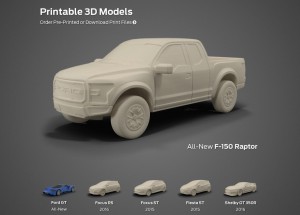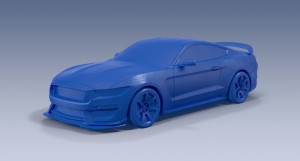Looking for an inexpensive Ford Mustang or F-150? Well, if you have a 3D printer you can download one and print one at home.
The use of 3D printers is growing quickly in the auto industry, including the production of an entire car using one. In fact, Ford CEO Mark Fields noted during today’s announcement about Ford’s plans to race the new GT at Le Mans, the company will 3D print the intake and some other parts for the GT they will race.
However, the Ford isn’t being quite so liberal with what they’ll be making available for printing. They will let you have the specs for a model-sized version of your favorite car or truck. They are available at The Ford 3D Store or 3D.ford.com. There are more than 1,000 images.
“3D printing at home is a growing trend, and it makes sense for us to offer our customers a chance to make their own 3D Ford models,” said Mark Bentley, licensing manager, Ford Global Brand Licensing. “At Ford, we’re using 3D printing every day to rapidly prototype parts, and now we want to share that fun with our fans.”
According to Juniper research, sales of desktop 3D printers will exceed 1 million units by 2018, from an estimated 44,000 sold annually in 2014.
For now, available for printing are the new Ford GT, F-150 Raptor, Shelby GT350R, Focus ST and Fiesta ST; however, the maker will make more printed models and digital files for additional vehicles available later.
The 3D-printed models are 1/32nd scale in plastic, but purchasing a digital image allows users to have a Ford model 3D-printed to the scale and of the material they choose, either from their own printer or from an outside source. Professional 3D printers can create a model in materials ranging from soft plastics to sandstone and even various metals.
(Ford, other automakers betting big on 3D printing. For more, Click Here.)
While models are nice, the use of 3D printing has been used in a variety of real-world applications, in particular, by racing teams. Chip Ganassi Racing recently used a variety of components produced by a 3D printer for use in a prototype it tested during the TUDOR United SportsCar Championship race at the Belle Isle Grand Prix in Detroit.
Powered by a Ford EcoBoost engine, with about 70% of the twin-turbo V-6’s parts street stock. Among the parts customized for the track was an intake manifold that was little more than a vat of goo and a digital file prior to the Daytona race. Ford turned to 3D printing rather than conventional manufacturing methods for the manifold and several other components.
(Click Here for details about Ford’s return to Le Mans with the GT.)
“3D computer printers have totally changed the development process for our Daytona Prototype race cars,” said Victor Martinez, 3.5-liter EcoBoost race engine engineer. “3D printing has advanced at such lightning speed in recent years that in a matter of hours, we can create real, usable parts for race cars. That’s exactly what we did for the 24 Hours of Daytona earlier this year.”
The U.S. military is experimenting with the idea of using the technology to produce critical parts for tanks and weapons right at the front, rather than having to wait for supply lines. At the other extreme, new 3D printers have dropped to less than $1,000, allowing tinkerers and small businesses to print out virtually any shape they fancy.
(To see more about the axing of the MKS paving the way for the Continental, Click Here.)
Automakers have become particularly intrigued with the technology because of the speed with which they can transform ideas into hard parts. That’s especially useful in the racing environment where competitors are constantly tinkering in a bid to improve performance on the track. But even for street use there are potential benefits.


